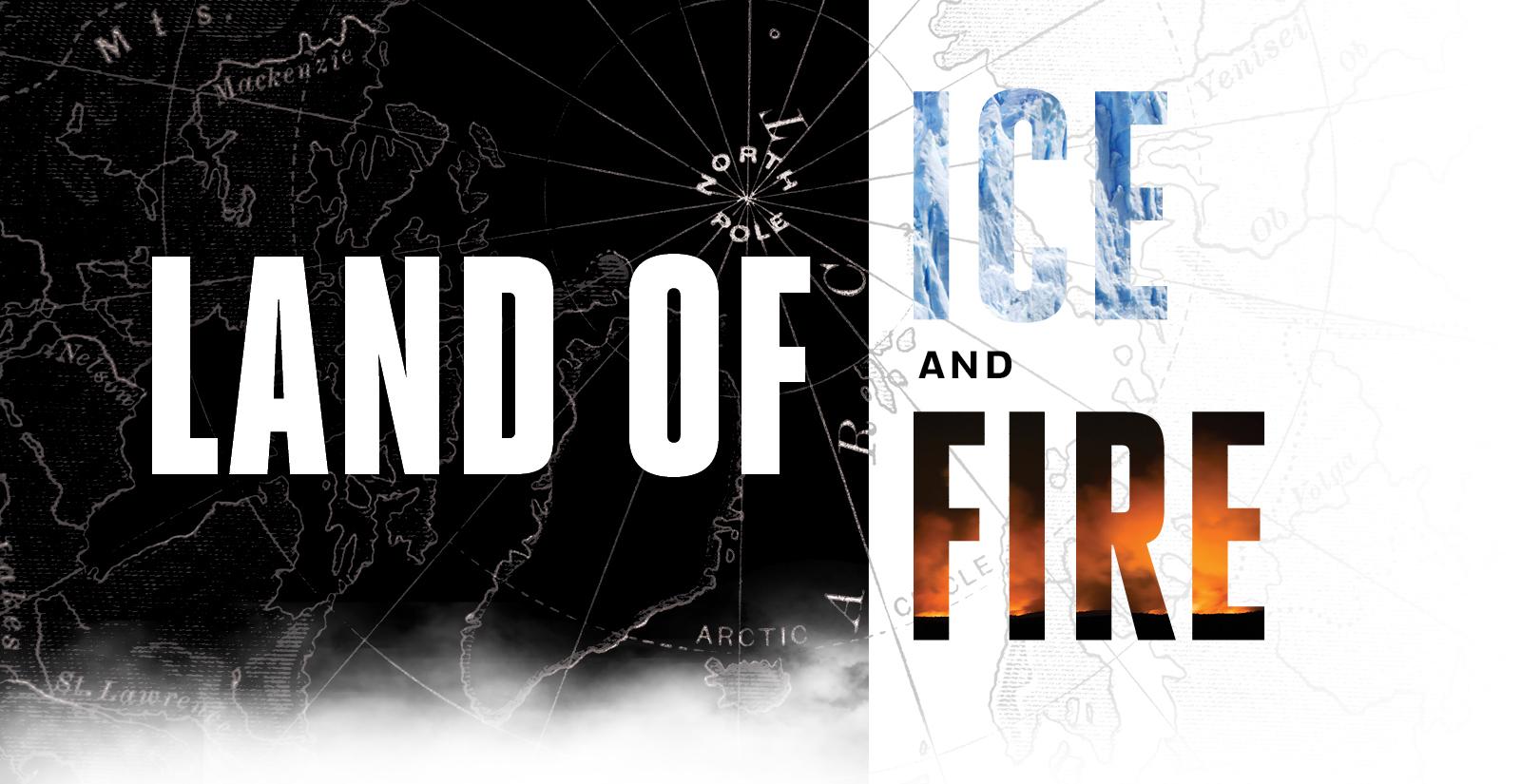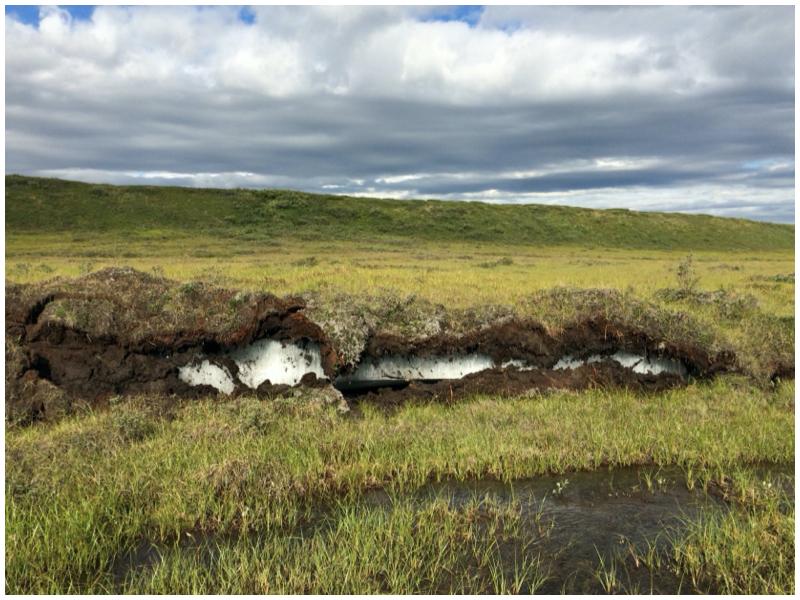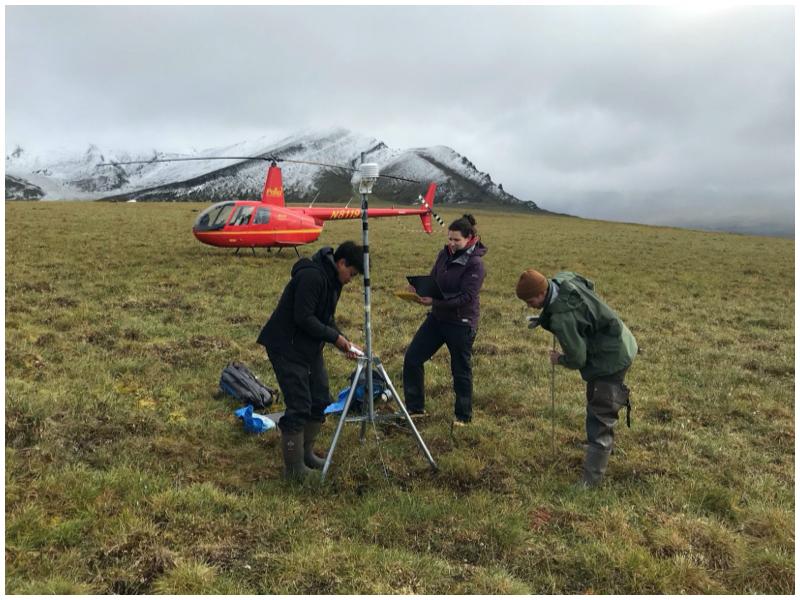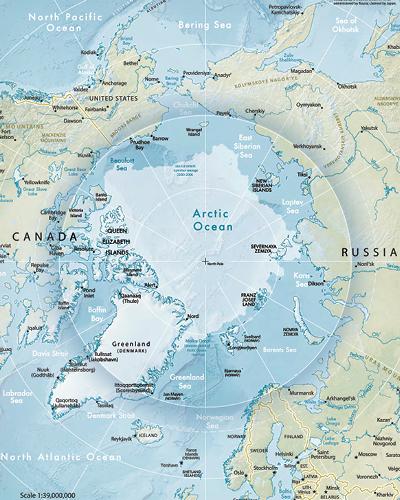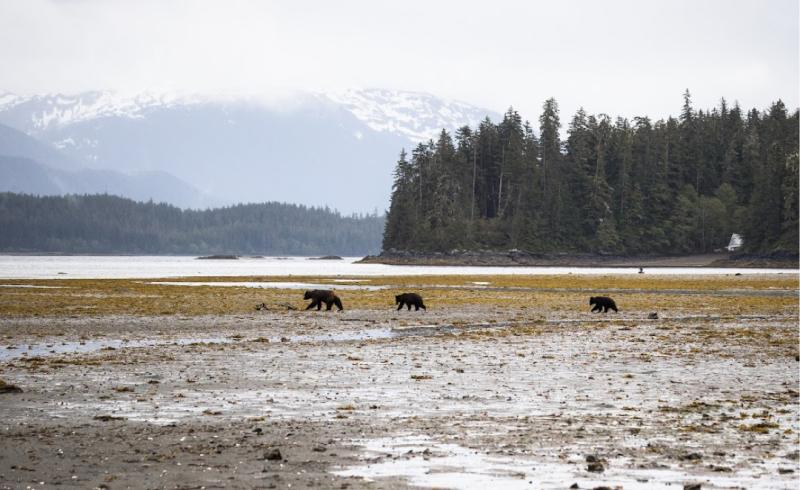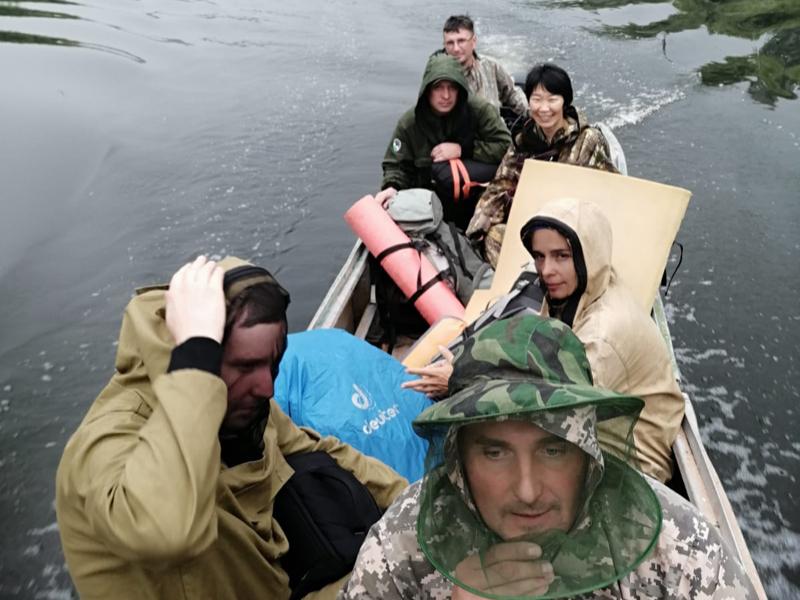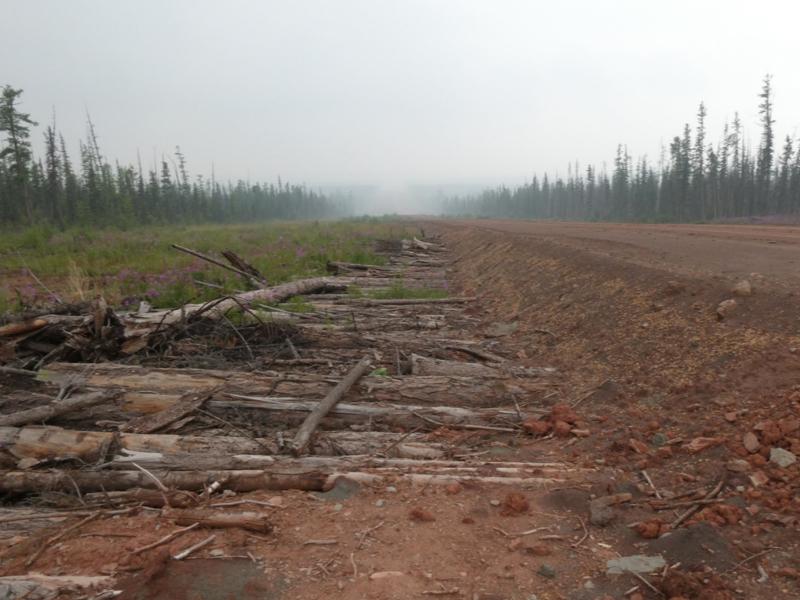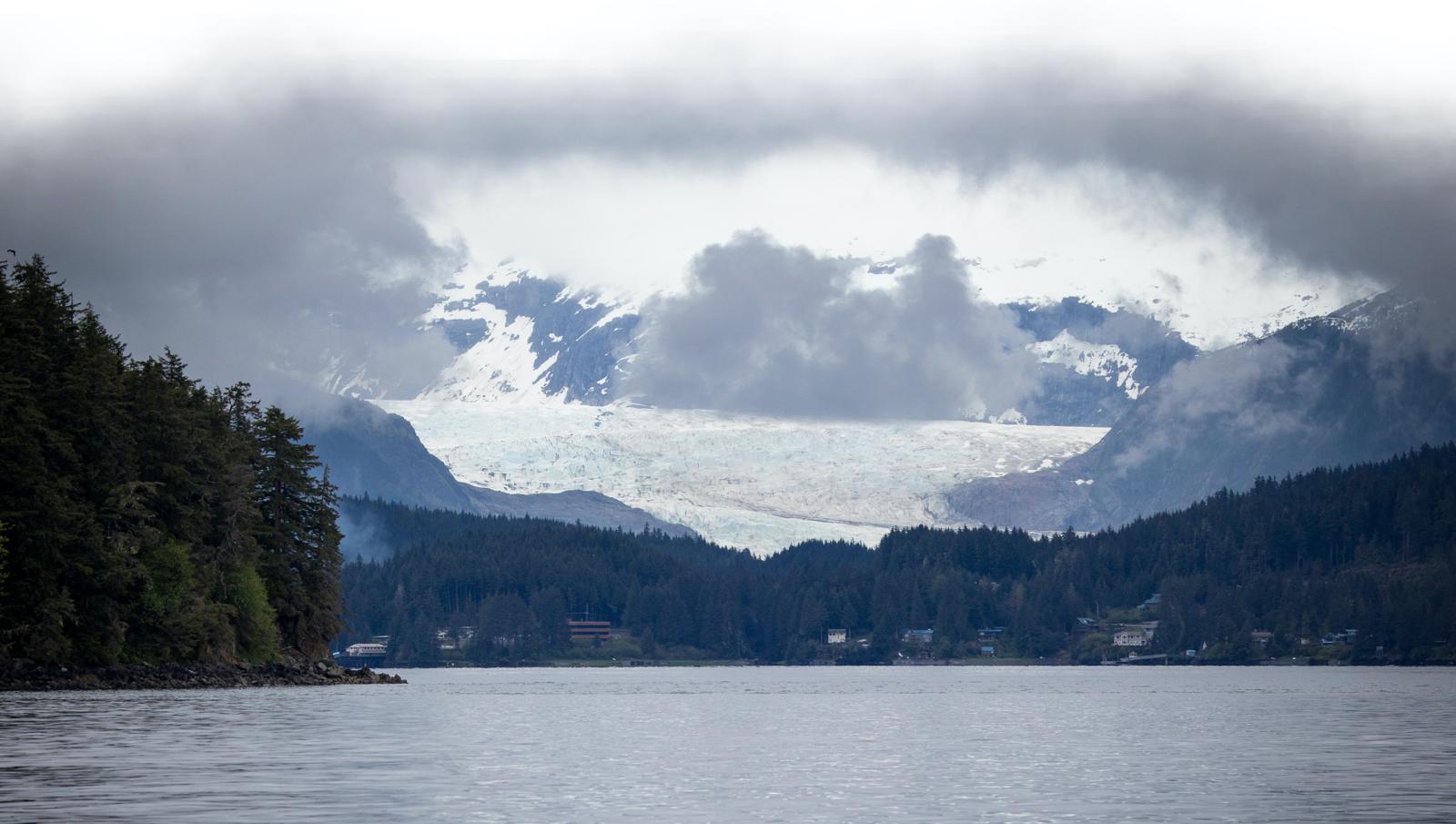Land of Ice and Fire
More than 4 million people live in the Arctic, where climate change is progressing faster than on the rest of the planet. Researchers across GW are working to help sustain their cities, infrastructures and cultures.
// By Sarah C.P. Williams
Every year, crews of Iñupiat men paddle from the northernmost reaches of Alaska into the Arctic Ocean in search of walruses, seals and bowhead whales. They float their catches back to land and—stocked with enough meat to last many months—lower it deep into the frozen ground.
In recent years, however, these ice cellars—or siguaq in Iñupiaq—have started to collapse, threatening the food security of entire communities. And it’s not just in Alaska. Ice cellars used by subsistence hunters in northern Siberia are also disappearing or decaying as the ground warms, says Dmitry Streletskiy, an associate professor of geography at GW.
“Imagine that you have a freezer—minus 18 degrees, and it becomes minus 15, minus 12, minus 10 and then minus 4. The meat is still frozen, but already some bacteria, mold starts to grow.”
To help intervene, GW researchers installed temperature monitors in traditional Iñupiat ice cellars in Utqiagvik, Alaska. They also mapped the cellars—71 in total—to help direct snow plow drivers away. (Counterintuitively, extra snow on top of an ice cellar can insulate and warm it.)
But the thawing siguaq are the almost literal tip of the iceberg when it comes to the challenges currently facing the people who call the Arctic home. With climate change, urbanization, political tensions, changing tourism and the boom-bust cycles driven by resource extraction, the Arctic is a place of upheaval. Unusual storms, increased wildfires, landslides, poor air quality and collapsing buildings are just some of what people there have faced in recent years.
The Arctic is “the canary in the coal mine,” says Robert Orttung, research professor of international affairs at GW. “What happens up there in the north is what’s going to happen to the rest of the planet next.”
In 2016, Orttung spearheaded the Arctic Partnership for International Research and Education (PIRE) project, an international research network based out of GW that aims to promote greater urban sustainability in the Arctic.
The project was funded by the National Science Foundation (NSF), which, in 2016, unveiled “Navigating the New Arctic” as one of its “10 Big Ideas”—grand challenges that identified areas for investment at the frontiers of science and engineering. In the Arctic, the federal agency sought to spur multidisciplinary research that would advance understanding of the local and global effects of a rapidly changing region.
Since 2016, more than a dozen scientists across eight schools at GW have received approximately $8 million in funding for Arctic research, much of it from NSF. They study areas ranging from geography, electrical engineering and transportation to politics and infectious disease.
GW Geography Research Scientist Vera Kuklina, for example, is leading a new NSF-funded project to study Arctic “frozen commons”— ice, snow and permafrost landscapes collectively used and managed by Indigenous peoples, local communities and governments. Kuklina comes from a nomadic, Mongolian-speaking Indigenous group in Russia and is passionate about including local people in research and planning.
“There’s a lot of knowledge that isn’t written down anywhere but exists about how people in the Arctic have adapted and kept in balance relations with their environment,” she says.
The Arctic is a diverse place, of course—small towns in Alaska may, on the surface, have almost nothing other than their latitude in common with industrial cities of Siberia. But when you look deeper at the political fabric of Arctic locales, you find connections, Orttung says.
“Throughout the Arctic, the drivers of change right now are the climate and the demand for resources,” he says. “Those shape everything we do.”
Kelsey Nyland (second from right), a research scientist in the GW Department of Geography, led students in mapping Iñupiat ice cellars in Utqiaġvik, Alaska. Credit: Vasily Tolmanov
Ground ice exposure along the Dalton Highway in the North Slope of Alaska. Thawing permafrost causes the road, the only route stretching north from Fairbanks into the Arctic, to frequently wash out. Credit: Kelsey Nyland
Nyland (center) and students measuring permafrost thaw on Galbraith Ridge in the Alaskan North Slope. Credit: Toolkit Field Station
The Arctic Circle wraps the globe at the 66th parallel, a line that cuts through Canada, Russia, Finland, Sweden, Norway and the top quarter of Alaska. Almost the entirety of Greenland falls inside the Arctic Circle, while only a handful of Iceland’s most northern peninsulas stretch into it, like fingers grazing a bowl. Above this imaginary line is the Arctic—land of the midnight sun and polar night. Here, the summer solstice is marked by 24-hours of constant daylight. On the winter solstice, the sun never appears.
At times, scientists have used summer temperatures, the edges of forests or the presence of sea ice to define the boundaries of the Arctic. But as the climate changes, these boundaries shift far from the 66th parallel. Areas historically considered Arctic by these standards are now too warm, watery or green.
“No region of the world is warming as fast as the Arctic,” says GW Professor of Geography Nikolay Shiklomanov. “I’ve been going there for almost 30 years, and you can see the change every year. It’s hard not to notice it.”
Indeed, the Arctic Council, an intergovernmental forum that addresses issues faced by Arctic governments and Indigenous people, concluded that the Arctic is warming about three times as fast as the rest of the planet. As the air warms, so too does the ground and the sea. Glaciers and sea ice retreat, and the dark open ocean absorbs more heat from the sun than the reflective ice and snow once did, increasing the water temperature and melting ice further. Partially decomposed plants and animals begin to decay again as the soil around them thaws—they too hasten climate change by releasing methane into the air.
Most people know some of this science—they can tell you that somewhere in the north glaciers are melting, releasing water that laps hungrily at coastlines around the world. But, in the 2016 NSF-funded Polar, Environment, and Science (POLES) survey, more than half of all Americans failed to recognize that the U.S. has any territory or people in the Arctic at all—let alone that an area of Alaska nearly the size of California lies inside the Arctic circle.
“Alaska shouldn’t be shrunk into a box on the side of U.S. maps,” Streletskiy says. “It makes it so disconnected. This is part of our country.”
Still, even if we are an Arctic country, why does this region matter so much? In other words, why should we care?
“There’s this perception that the Arctic is this white, uninhabited place with polar bears. But there are cities there. There are industries and people and communities. The economy of the Arctic is the size of the economy of Malaysia,” Streletskiy says.
Although that survey on Arctic perception didn’t ask, most Americans likely wouldn’t correctly guess that, across eight countries, 4 million people live in the Arctic. The region includes 10 cities with populations of at least 30,000—the size of Alaska’s capital city, Juneau (which itself lies about 600 miles south of the Arctic Circle).
Some of the reasons we should care about the Arctic are the same reasons we should care about anywhere—compassion for our fellow humans and a desire to preserve the diversity of spaces, flora and fauna on our planet, Streletskiy says. But others are more tangible and self-serving.
“Changes in the Arctic affect everything else globally,” he says. “It’s the kitchen of the climate.”
He means, of course, that the weather in the Arctic shapes weather patterns around the globe. Not only do melting glaciers feed rising sea levels, but warmer Arctic air and water affect trade winds and weather systems as far away as the equator. A warmer Arctic means more droughts and severe storms for all of us.
Moreover, Streletskiy adds, the lessons we learn in the Arctic can be applied elsewhere. Best practices to slow coastal erosion in Norway might also be useful in Florida. Lessons on sensing wildfires in Alaska surely have application in Los Angeles. And, ultimately, if researchers can make the Arctic—an isolated land of unpredictable fire and ice—a sustainable place to live, then maybe the rest of the world has a shot.
“No region of the world is warming as fast as the Arctic. I've been going there for almost 30 years, and you can see the change every year. It's hard not to notice it.”
Nikolay Shiklomanov
Professor of Geography, Columbian College of Arts and Sciences
Photo Credit: Stanislav Podusenko
Shiklomanov has been visiting the same places in northern Alaska for so long that he talks about the journey to get to them in the same tone he might describe an outing to the grocery store. The trip, however, involves helicopters, hundreds of miles on dirt roads and backpacking—sometimes hiking 10 miles a day—to remote field sites. “We have to carry guns for protection against bears,” he says.
Shiklomanov, in collaboration with Streletskiy, studies permafrost—soil or sediment that remains frozen year-round. Once, permafrost was considered permanent, hence its name. Now, however, much of it is thawing and the implications are far-reaching. Melting ice embedded in permafrost causes ground surface deformation and collapse, changes drainage patterns and triggers landslides.
“For decades, permafrost has been treated as relatively solid ground for pipelines, roads and buildings,” says Shiklomanov. “Now, when the permafrost thaws, that ground can collapse.”
A team of GW researchers led by Shiklomanov wants to better understand the process by which permafrost thaws, and how this weakening of the natural landscape affects the people and cities of the Arctic. They have been monitoring permafrost changes by measuring ground temperature and the depth of summer thaw at a large number of sites distributed across the Arctic. Some sites that were established to represent grassy tundra a mere five or 10 years ago are now covered with knee-high shrubs. The change in vegetation is another sign of the warming climate, with thicker shrubs making permafrost more resilient than once thought and insulating the ground from summer heat. “In the 1990s, we had this assumption that as the climate warmed, the permafrost would thaw quite fast,” says Shiklomanov. “Now we’re finding that it’s surprisingly robust.”
But there’s a tipping point to permafrost robustness, Shiklomanov notes. The thawing of permafrost doesn’t happen at a reliably steady pace. Instead, it can warm slowly until it hits a threshold—and then it can thaw quickly and dramatically, affecting the stability of the landscapes and infrastructure built on them.
As part of another NSF-funded project, Shiklomanov and his colleagues will monitor the permafrost-affected landscapes in order to better understand the relations between climate and permafrost and to identify areas threatened by permafrost thaw.
For years, Streletskiy has been sounding the alarm about the damage that warming permafrost can do to Arctic cities. In Igarka, a shrinking lumber town in northern Siberia, buildings constructed during the mid-20th century—the town’s heyday—are now crumbling as their foundations sink into degrading permafrost.
In the early 2000s, the government resettled more than a thousand people whose homes in Igarka were collapsing. The same, Streletskiy says, will happen in dozens of other Siberian outposts, where—for many years—posts were pounded into permafrost as if it were concrete.
A building in Igarka, Russia shows signs of structural deformation as the permafrost underneath thaws. Credit: Dmitry Streletskiy
“We’ve been telling people to pay attention for two decades,” he says. “But these local decision makers have other things keeping them busy.”
One of the reasons it’s so easy to ignore, Streletskiy explains, is that thawing permafrost is like ice cream on a stick. For a while, it can warm up and keep its shape. You don’t notice that it’s losing stability. Then all of a sudden (and often too late to save infrastructure), it starts to slide. It’s the same idea of a tipping point that Shiklomanov’s data showed.
“You might not know that your house is on this unstable permafrost unless you measure it,” Streletskiy says. “It might look okay until it’s not.”
In 2019, using some of the data that he and Shiklomanov had collected from hundreds of boreholes drilled into the Arctic permafrost, Streletskiy worked with economists to model the future effect of thawing permafrost on the Russian economy.
By 2050, they concluded, the cost of replacing damaged buildings and infrastructure could add up to more than $67 billion in U.S. dollars. Those dollar signs, he says, began to catch some policymakers’ attention.
Then, in mid-2020, a diesel oil tank collapsed at a nickel mine in Norilsk, less than 150 miles north of Igarka, and 21,000 tons of oil leaked into the Ambarnaya River. The assumed cause of the collapse: The permafrost around the tank had thawed and given way.
A week after the spill, the Russian government announced that it would begin inspecting other potentially dangerous infrastructure at risk from permafrost changes.
“They didn’t pay proper attention to the permafrost, and I hope this changes that,” says Streletskiy.
In 2019, gusts of wind sent a tree careening onto power lines near Anchorage, Alaska. The lines—pulsing with electricity—hit the dry undergrowth below and sparked an immediate fire. Within a day, 52 homes and three businesses had burned to the ground. As the fire spread over subsequent days—eventually burning more than 3,000 acres of land—additional trees collapsed on power lines and poles. It took weeks for power to be fully restored to the region.
Every summer, hundreds of wildfires burn millions of acres of land in and near the Arctic. They blanket the region in smoke, lower air quality and destroy forests and structures. They affect millions of people’s lives. Orttung’s group ran focus groups in 2020 and 2021 to better understand the impacts of wildfires on Arctic communities.
“You don’t know that [the smoke] is affecting you until you wake up in the morning with a sore throat or scratchy throat,” said one participant in Alaska.
“You can be cut off from family and friends and shops,” said another from Sweden.
These fires have happened for decades—the Alaska Fire Control Service was first established by Congress in 1933 in response to the number of fires in the state. But now, like fires in many places around the world, they’re getting worse.
“Record-breaking temperatures and the resulting dried-out vegetation in Alaska have fueled major fires in recent years,” says Payman Dehghanian, an assistant professor of electrical and computer engineering. “Such events are projected to increase in both frequency and magnitude.”
Dehghanian received an NSF grant in 2020 to study the interactions between wildfires in the Arctic and energy grids, including Alaska’s unique network.
In the mainland United States, Dehghanian explains, a power outage in one area can often be solved—even in advance of repaired power lines—by rerouting energy from another area. But in Alaska, there are more than 200 remotely powered, isolated villages; if a wildfire or ice damage breaks the single line connecting one of these villages to their power source, they often lose power for days until the failure is fixed.
Dehghanian, through conversations with engineers, social scientists, local utility companies, firefighters and policymakers, has been trying to wrap his head around how to break the cycle of electrical grid damage and wildfires in these remote places.
“On the one hand, the energy network can trigger wildfires when wires fall,” he says. “On the other hand, the fires can damage the energy network.”
The problems associated with numerous and lengthy power outages, Dehghanian says, can be solved in part with investment in mobile and renewable power sources—including backup generators, battery storage units and mobile wild turbines. (Solar energy can be difficult to obtain during the smoky conditions of a wildfire). But better sensing and monitoring—of both wildfires and the electric grid—would go further toward preventing outages and damage in the first place, he thinks.
Dehghanian is working on a new technology that might be especially useful in Alaska: an intelligent system that senses a broken powerline and, in the split second before the live wire falls to the ground, isolates the section of wire and cuts off the electricity flowing through it in an automated manner.
“By the time the wire hits the ground, there is no electricity, and there is no risk of sparking a fire,” Dehghanian says.
Learning about how this kind of innovative solution might be applied in Alaska can go far in not only helping lessen the effect of wildfires on Alaskans, but in deploying such technologies in other places—from California to Brazil and Australia.
“When we first started working on this project, our goal was to learn from other parts of the country and the world and apply that knowledge to Alaska,” says Dehghanian. “But we found there are also opportunities for others to learn from Alaska. These solutions that we will be trying on detection, prevention and mitigation can be applied elsewhere.”
The Arctic is “the canary in the coal mine. What happens up there in the north is what’s going to happen to the rest of the planet next.”
Robert Orttung
Research Professor of International Affairs, Elliott School of International Affairs
Norilsk—the Russian city where an oil tank collapsed into thawing permafrost—is known for something else. Blanketed in black snow at times with air that tastes of rotten eggs, it’s been called the world’s most polluted city. And it’s not the only northern locale plagued with smog. In recent years Fairbanks, Alaska (which lies outside the Arctic Circle but is often considered a gateway to the Arctic), has topped a list of most polluted cities in the United States published by the American Lung Association.
Like other problems exacerbated by the dual threat of climate change and urbanization, Arctic pollution is getting worse. Throughout the early 2000s, Fairbanks averaged between five and 10 days a year with unhealthy air; between 2017 and 2019, the average was 35.
“It’s counterintuitive because we think of the Arctic as this pristine place,” says Susan Anenberg, associate professor of environmental and occupational health and of global health at the Milken Institute School of Public Health and director of GW’s new Climate & Health Institute.
Despite its vast wilderness, the Arctic has a confluence of stagnant air, wood smoke and pollution that drifts northward from the rest of the planet. In industrial cities of Siberia, like Norilsk, pollutants spew from mines and factories, puffing black smoke into the air. But even small Arctic towns in Alaska and Scandinavia struggle with air quality.
“Even though we’re generally talking about small towns and cities, wood combustion is pervasive in the Arctic,” says Anenberg. Some of that wood combustion comes from wildfires, but it also comes from the Arctic way of life. People heat their homes with wood, cook on wood and smoke fish on smoldering wood.
That’s not all. In most places around the world, the air is colder the higher you go. In some places in the Arctic, the air is frequently inverted, with a layer of warm air on top, trapping pollution in place. It’s one of the reasons that air quality models, designed to simulate how proposed policy changes might affect air quality, are hard to apply to Alaska.
“A lot of our analytical tools don’t work in Alaska,” says Anenberg. Instead, she says, scientists like her must assemble new models from the ground up—a painstaking task that slows research.
With Orttung, Anenberg is carrying out studies on how forest fires and climate change affect air quality and, in turn, public health. Anenberg is analyzing recent wildfire episodes in conjunction with local medical records to see whether worsening air quality causes more people to die. This kind of analysis might help answer one of her lingering questions: Is burning wood more or less toxic than other kinds of pollution?
“Here in D.C., most of our pollution is from industry and vehicles. We’re burning a lot of natural gas, gasoline and diesel but we’re not burning very much wood so we just can’t study it,” says Anenberg. “In the Arctic, we have the ability to study pollution from wood combustion and that can help us improve our models elsewhere.”
And it’s not just the air quality affecting health in the Arctic. The presence of infectious diseases, and the changing burdens on the health system, are shifting as well, says infectious disease physician Hana Akselrod.
An assistant professor of medicine at the School of Medicine and Health Sciences, Akselrod has introduced lectures on climate change and health into the medical school curriculum. Her interest in the topic began with curiosity about how climate change affects infectious diseases—by changing the geographic range of disease-carrying insects, for example—but quickly grew broader.
Akselrod, who is collaborating with Dehghanian on a study to understand forest fire impacts (for example, fires connect climate change to asthma rates), shifted gears when COVID-19 began. Over the course of 2020, she has been collaborating on a study to look at Juneau’s response to the pandemic.
After her infectious disease residency in Maine, Akselrod thought she had some insight into what it’s like to live in a cold, coastal environment with isolated medical care and self-sufficient communities. “But whatever challenges we had in Maine, they’re amplified by several orders of magnitude in Alaska,” she says. “COVID was this opportunity to get some real insight into how an emerging infectious disease impacts a community like this.”
Community cohesion, strong communication, as well as the Indigenous historical memories of the 1918 flu—which disproportionately affected Native Alaskans—helped Juneau respond relatively effectively to the pandemic, Akselrod says.
“Looking at a small, contained community with a lot of resilience afforded us an opportunity to look at where things went right, and how the community adapted when things didn’t go right,” she says. “I think this is key to charting a course through not only COVID-19 or the next pandemic but also to the greater threats to health that are coming with a rapidly changing climate and destabilized natural environment.”
She points to a recent mysterious anthrax outbreak in Siberia that was traced to thawing permafrost. Anthrax spores had hidden, frozen in the icy ground, for years—perhaps decades. When the permafrost began to warm, the spores came alive again, a kind of zombie bacteria. Grazing reindeer picked up anthrax on the tundra and spread it to dozens of people.
“We think of the Arctic as this pristine place,” says Susan Anenberg, director of GW’s Climate & Health Institute, but regions like Admiralty Island, Alaska, face challenges such as pollution and wildfires. Credit: Hana Akselrod
Ultimately, the changing pressures on the Arctic are changing what it means to live in the far north. Researchers like Orttung and Kuklina want to know how, in the face of these changes, Arctic cities—and entire cultures—can survive. Orttung, again and again, comes back to the idea of sustainability. He is trying to understand how to make Arctic cities more sustainable—and how to gauge their sustainability in the first place.
“In the Arctic, but also elsewhere, sustainability means making cities where people can live in a way that doesn’t make it difficult for the next generation to live in the same way,” Orttung says. “It means not using more resources than you consume.”
Researchers around the world use urban sustainability indicators to help determine how sustainable local governments are. But in 2020, Orttung reported that one of the most commonly used of these indicators—an index known as ISO 37120 that measures city services and quality of life—is only useful as a starting point for Arctic cities.
“In a lot of ways, Arctic cities aren’t that different,” he says. “But these international standards don’t take things like permafrost and extreme isolation into consideration.”
To help build new indicators that can be used to design more sustainable communities in Alaska, Orttung is collaborating with Jim Powell, an assistant research professor at University of Alaska Southeast and former deputy mayor of Juneau. Powell has lived in Alaska for 45 years and seems to know just about everyone in the state doing anything related to sustainability.
“You can’t manage something unless you can measure it,” Powell says. “But if we want to get local decision makers on board, we also need to keep it simple.”
Frequently used indexes like ISO 37120 include more than 100 sustainability indicators. Powell points out that most local governments don’t have the time or patience to track this many indicators. He and Orttung recently contributed to a sustainability plan for Fairbanks and homed in on just three indicators for city officials to follow: food, energy and waste.
Orttung has carried out research on, among many other topics, how to make Arctic recycling programs cost efficient, what factors affect the sustainability of solid waste management programs, how to boost food security in northern Alaska and how cruise ship tourism is affecting the economies of Arctic cities.
He’s found that the more people in a city turn out to vote in elections, the better the city seems to rank in measures of sustainability. It’s one of the reasons he and Powell strive to involve local stakeholders—from farmers and Indigenous groups to city council members—in their work.
Powell and Orttung push for what Powell calls “co-design.” As he defines the term, “it means you involve locals from the beginning.”
It’s a sentiment that Kuklina, as she studies local knowledge in the Arctic, strongly agrees with. Kuklina says that much of her work couldn’t be done at all without close-knit ties to Siberian locals. One of her most recent projects involved mapping an entire network of informal roads that snake through Arctic forests in Russia.
“This project actually happened because I was up there doing something different and people just kept talking about all these roads that didn’t exist on maps, and how important they were for locals,” she says. “I realized that nobody usually took them into consideration for environmental planning.”
To map them, Kuklina had to find them—that required tips from local hunters who regularly use the roads. Some, she found, were roads long ago established by oil and gas companies and believed to be abandoned. Others were widened from animal paths, and some had originated from long straight stretches of forest cleared for forestry or power lines.
“What I found was that these roads have a big impact on all sorts of things, from animal migrations to forest fires,” says Kuklina. “And nobody other than the locals had paid attention to them before.”
Her backcountry travels on these informal roads—which often involve broken down off-road vehicles being tinkered with before the trips can progress—have also given her a glimpse at the effects of climate change. The roads and shoulders of the roads, most of which are built on permafrost, are cracking and drooping. Rivers, she says, are becoming shallower because of climate-related changes to waterflow. The hunters who guide her in the forested taiga tell her that plummeting fish and animal populations are making them abandon traditional hunting and consider moving to larger cities.
Now, Kuklina has turned her attention to how local communities use and manage green and blue spaces and, when they are covered with snow and ice, “white space.” Like Orttung and Powell, she thinks that studying the sustainability of Arctic towns and cities can help inform us about creating a more sustainable world.
Researchers document erosion and solifluction--when soil flows downslope due to the thawing of frozen ground--after clay and sand were dug out to pave a road in Siberia. The surrounding subarctic forest, called taiga, has been impacted by forest fires, a widespread phenomenon in the Arctic. Credit: Natalia Krasnoshtanova
After using informal (mostly forestry) roads and an off-road vehicle to get as far as they can by land, GW Geography Research Scientist Vera Kuklina (back right) travels with Russian colleagues by boat to the village of Tokma, where no permanent roads connect the village with other settlements. The team wears face nets to protect against mosquitos, which are abundant in the area. Credit: Natalia Krasnoshtanova
Logs help stabilize a road built on permafrost in Siberia. Wildfire smoke obscures the sun and horizon. Credit: Stanislav Podusenko
Nearly all the researchers say they wish more people appreciated the Arctic’s importance. Not just its natural beauty—icebergs on a nature documentary or glaciers viewed from a cruise ship window—but the diversity of people and cultures, its unique urban fabric and the outsized challenges the region faces.
That’s one reason GW Associate Professor of International Education and International Affairs Laura Engel launched #60above60, a program that pairs students in Washington, D.C., with students living above the 60th parallel in Alaska, Norway, Canada, Finland and Russia.
“I think it’s valuable for students who live at a great distance from the Arctic to see how their lives and their communities are intimately connected to what’s happening in the Arctic,” says Engel.
Through the program, students create and share 60-second digital stories that relate to the environments of their homes and communities. Engel and her GW graduate students are now studying whether the program informs students’ pro-environmental behaviors and ability to connect what’s happening around the globe with their own local community. The researchers are still analyzing data from student participants.
“What we hope,” Engel says, “is that this kind of program leads to enhanced perspectives about how different communities live, how their communities thrive and that it contributes to young people’s deeper thinking about sustainability and conservation.”
Engel would like to eventually expand #60above60 and involve college students in these kinds of global exchanges. Everyone, she says, could benefit from learning more about the ways their lives are connected to what is happening in other places.
Orttung agrees and cites signs of momentum. The Biden administration, for example, has signaled it wants to make science and the input of Indigenous people a higher priority in U.S. Arctic policy. The five new commissioners and one reappointed commissioner to the U.S. Arctic Research Commission (USARC) reflect a significant shift: One-third of the current commissioners are now Indigenous, half are women and two-thirds live in Alaska.
“The consequences of global Arctic [policy] ripple all over the world,” said newly appointed USARC chair Mike Sfraga in a statement. “It’s very refreshing to see the United States leaning forward like this.”
The new officials also said they plan to address issues around economic development, infrastructure, shipping, tourism, sustainability and food security in U.S. policy.
“You would hope people would think through the fact that our whole planet is interconnected,” Orttung says. “Even though the Arctic is far away, it still has an impact on our daily lives.”
Credit: Hana Akselrod


